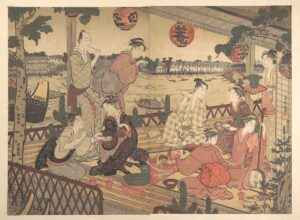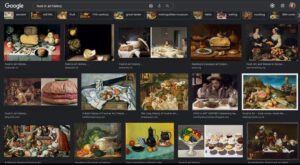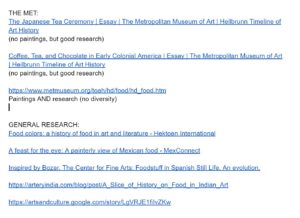When making a project that is intended for the public, it’s important for us to consider the role that inclusion and diversity should play to help form a well-rounded and well-informed capstone.
Intent:
My capstone intends to create a deeper understanding of food and the culture surrounding it through cultural appreciation, historical context, and artistic interpretations. With my exhibition, I aspire to…
- Encourage audiences to look beyond their own cultures and learn about different practices, rituals, and connotations with food.
- Show the varying artistic interpretations and styles of different periods and regions through diverse artists and paintings.
- Educate viewers about the history of food within society, and the underlying contextualization that foods were associated with.
- Engage viewers in art history, inspiring them to further their knowledge of it and immerse themselves in it more through different mediums and platforms.

Two Young Men and Several Women Dining at a Tea House on the Bank of the Sumida River- An example of the type of paintings I hope to include that features different non-Western cultures
Impact:
When considering my project as a finished product and opened to viewers, I hope that the impact will be an engaging and educational experience that sheds light on the history and art of diverse cultures and artists that are often overlooked in the Euro-centric representations of art history. Too often, many exhibits and museums tend to lean heavily into Western art and interpretations, being products of their inherent history of colonization, “exoticism” of non-white cultures, and a general lack of engagement with art that deviates from the traditional Western academic standard.

A prime example of orientalism done by Western artists, appropriating Eastern cultures
I think that by creating an exhibit that includes and engages with diverse art, audiences of any type will be able to resonate with the selection of paintings and gain a deeper appreciation of different cultures. And of course, some additional education on the history of food would have an expected impact. My project will have value on audiences who find interest in food, history, art, and want to gain a broader perspective of art history and food culture that extends beyond the Euro-centric standard.
Best & Worst Case Scenarios:
Best:
The best-case scenario would be that my art exhibit and marketing successfully engages with a broad and diverse audience who can learn more about food within art history in regards to its context, culture, and societal nuances through a variety of paintings that cover different periods, geographical regions, and artists.
Worst:
The worst-case scenario, to put it politely, is my nightmare. I think it would be that my marketing campaign would fail to reach out to a wide array of audiences that include my target audiences, and that the audience would fail to understand or enjoy the selection of paintings chosen. Or, even worse, my efforts to include the large variety of artists and cultures would come across as culturally appropriating rather than appreciation, or that I had failed to properly inform my audience about the painting, the subject, the artist, or the historical context of it. But, the most realistic scenario is that there won’t be as much diversity as I want and the exhibit will be more Euro-centric than hoped for, as there is a surprising lack of diverse food-related paintings in comparison to the European-made paintings in museum collections that are open domain.

Just looking up “food in art history”, only European or Western art shows up.
Personal Identity:
While designing my exhibit and marketing campaign, it’s important to note that I am a white woman who has been privileged in my upbringing and education and that I will strive to keep my personal experiences and privilege away from swaying any design choices. Specifically, I’m considering that I will do more in-depth research about paintings from different cultures and demographics to be certain in providing proper representation and information about the diverse cultures and artists. And, while making the marketing campaign, I want to include aspects from the exhibit that aren’t all Western-based art. Therefore, I am hoping that I can utilize my privilege of access to a good education and academic resources to fully educate myself and represent diversity in the exhibit to the best of my ability.
Missing Experiences:
Seeing that I am, as said before, a privileged white woman, I understand that I might be excluding perspectives on paintings and subject matters that don’t pertain to me. While I can do all the research in the world to give an educated perspective, I cannot have the lived experiences of some of these cultures and practices surrounding the food, history, or art. So, I must take extra care to educate myself properly on each painting’s diverse background and to find resources from lived experiences and perspectives from the community the painting stems from. I fear that I may not be able to represent as many communities as I hope, but am striving to give a wide array of backgrounds, cultures, practices, and periods with my selection of paintings.
Inclusivity Initiative:
In consideration of everything previously said, I think the best way for me to approach my capstone is to try and embed inclusion into literally every aspect of the project. From picking the paintings, doing the research, writing the info panels, and designing the marketing campaign, I want to be sure that the exhibit emphasizes diversity and inclusion. However, this is easier said than done, and it will require extra attention to be sure that I am not limiting myself to my personal experience, or ignoring any perspectives or misrepresented communities that could be harmed by a negative impact from the project.

A sample of my early research, where I’ve tried to include diversity from several cultures that are well-informed.
With this in mind, I intend to make sure that my paintings are diverse in artists, cultures, and styles, that my research spans beyond a Western education, that I take time to listen and learn from different perspectives when the opportunity arises, my info panels are well-founded and informed, and that I design marketing that is inclusive to all potential audiences.
February 22, 2022 at 6:51 pm
Emma,
This is just a wonderful post that weaves inclusion and diversity through your entire discussion.
I think the biggest obstacle we’re going to need to consider is the lack of open source work—which is really only an issue because of the software you have chosen to present gallery installation. Such a limiting structure could be removed, of course, or we need to locate creative work-arounds. Let’s find some dedicated time soon to start talking about that.
Looking forward to seeing it!
Bill